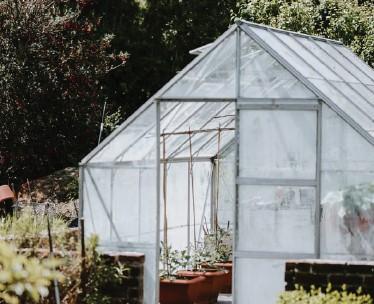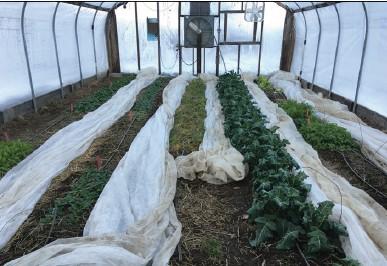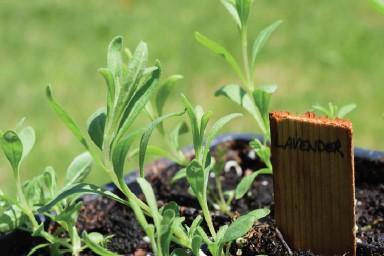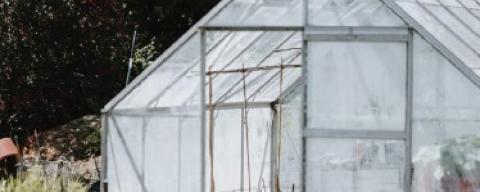
Before purchasing a greenhouse of any size, think about what you’d like to use the house for, and how it fits into the way you use your yard.
When a gardener has had some success with growing plants “in season”, often the next logical step is to work on extending the season or even controlling the growing environment using a greenhouse. Many options exist for small greenhouses, and their uses and limitations should be understood before purchase. If you are new to scheduling garden crops, refer to Growing Vegetables: When to Plant your Vegetable Garden. The crops listed in that publication that are “safe to set out in garden…after the last frost,” are warm season crops for the sake of the following discussion. “Cold-tolerant” crops are those which can be sown or set outdoors before the last frost date.
A commercial greenhouse is a structure intended to be heated with fuel to allow production of plants during a time of year when the plants could not develop on time or survive outdoors due to low temperatures. A greenhouse performs the competing roles of keeping heat inside at night, while still allowing in sunlight necessary for plant growth during the day. Without a heat source, a greenhouse would cool off very quickly when the sun goes down and get almost as cold as the outside air as the night progressed. Also, because greenhouses do a good job of allowing sunlight in, they can quickly heat up during the day to temperatures damaging to plants, even on very cold days, so they must have ventilation systems to allow excess heat to be released.
A high tunnel, by contrast, is a heated or unheated greenhouse structure over soil. These are used primarily to allow planting in ground earlier in the season or to keep crops growing later in the year than they would be able to if unprotected. The soil in a high tunnel in New Hampshire doesn’t freeze over winter, so these can be used to grow cold-tolerant crops all winter long with the use of specialized “frost blankets”.
For More Information
If you are new to scheduling garden crops, refer to this link to online fact sheet entitled, Growing Vegetables: When to Plant your Vegetable Garden, The crops listed in that publication that are “safe to set out in garden… after the last frost,” are warm season crops. “Cold-tolerant” crops are those which can be sown or set outdoors before the last frost date.
Growing in Pots or Growing in the Ground
An important distinction in commercial production methods exists between growing in pots and growing in the ground. Due to the geothermal effect of the earth and the solar capture effect of the structure, properly managed, the soil in a high tunnel can remain unfrozen all winter, while potting soil in a

Floating row cover ("frost blankets") on a winter crop in a high tunnel.
pot on a bench in the same structure would freeze solid. This means that in an unheated structure, in-ground production of cold tolerant crops can occur all winter long, while in-pot production during winter is limited to overwintering of hardy perennials. Whether you intend to grow in the ground, in pots, or both will affect how you utilize a backyard greenhouse.
Small Backyard Greenhouses
Non-commercial gardeners often hope to recreate the techniques of commercial greenhouse growers on a small scale using very small (less than 288 square feet) “backyard” greenhouses. These little greenhouses have some severe limitations, however. Left to their own devices, when the sun comes up, they heat up rapidly (often too much!), and when the sun goes down, they cool off to ambient temperature about an hour or two after nature. Without supplemental heat, you can’t put warm season crops in them until a week or so before outside is safe (perhaps in Mid-May in New Hampshire).
A greenhouse holds heat as a function of its volume and loses heat as a function of its surface area. The ratio between those two is much closer in a small structure than in a large structure. What this ends up practically meaning is that if you have a heater big enough to overcome the temperature loss on a cold night, that same heater is too big for a less cold night, and the heater will “short cycle”, turning on and off rapidly all night long.
Because of the likelihood of the air temperature inside of a small, unheated greenhouse reaching freezing when it’s freezing outside, these greenhouses are not a good bet for seed-starting warm season crops like tomato, pepper, cucumbers, squash, impatiens, geraniums, etc. It’s just too likely that the young plants will get chilled in late April/ early May, and if you’re starting these seeds later than that, they will be too late for a good gardening season in New Hampshire.
Did You Know?
A greenhouse holds heat as a function of its volume and loses heat as a function of its surface area. The ratio between those two is much closer in a small structure than in a large structure.
Plant growth is driven by the Average Daily Temperature (ADT) (within the high and low limits of the plant) and by increasing the daytime temperature, these houses increase the ADT versus outside, even if they don’t increase the lowest temperature reached at night. What that means is that, due to the trapped solar energy, these houses can make plants grow faster than if they were being grown outside. What these houses can do very well is to grow plants in-season (or a week or two earlier or later) faster. Cold-tolerant vegetables, like cabbage, kale, broccoli, leek, onion, spinach, pansy, snapdragon can be grown as seedlings in April to be transplanted into the garden later. Or, warm season plants like tomato, pepper and eggplant grown in large pots in the very small greenhouse after mid-May will fruit and ripen sooner than they would outside (just don’t allow the greenhouse to overheat; more on that later).

A very small greenhouse can be used for starting seedlings of cold tolerant crops.
If a very small greenhouse is over exposed garden soil, cold tolerant crops like spinach, kale, collards, etc. can be planted in the ground inside a very small greenhouse in August or early September, and these crops can stay yummy late into winter, possibly even all winter long. Consider purchasing some floating row cover (blankets) to pull over the plants at night if you’re going to try this approach. A raised bed inside the greenhouse can be more convenient than inground production. If the raised bed is in contact with the ground it may also allow for winter-long production but will be more prone to freezing than the ground itself.
If you are going to produce seedlings for transplant, a useful addition to a very small greenhouse is an electric heat cable buried in moist sand or an electric heat mat on a bench. By placing seedling trays on top of this mat, you can achieve better germination at lower air temps. Be sure to take the seedlings off as they emerge, or they will stretch. You could pull a blanket over them at night or even build a second “micro greenhouse” from some hooped wire and plastic over the heat mat to trap the heat.
Cooling very small greenhouses can be a real challenge as well. Even during cool, sunny spring and fall days they can heat up quickly and harm the plants inside. People intend to be diligent about opening and closing the house daily, but it only takes one sunny afternoon with forgotten vents to ruin a season of plants. When purchasing one of these houses, it is strongly recommended that you invest in an automatic vent opener for the spring and fall, and perhaps roll-up sides for the summer.
Consider Your Goals
Before purchasing a greenhouse of any size, think about what you’d like to use the house for, and how it fits into the way you use your yard. If, for example, all you want is to start tomato, pepper and eggplant transplants to go into the garden on June 1, it may make more financial sense to invest in a good set of lights and shelves to do this indoors. If, however, in-ground season extension and cool crop starting on benches are your goals, then a very small greenhouse may work well for you.
When deciding whether to purchase a very small greenhouse, don’t forget to consider the intangible benefits as well as the practical. Some of these very small greenhouses look really cute in the yard and stepping into a sunny 68 °F mini house on a cold February day is really good for the soul! (Just remember that it could get to 0 °F that same night in there!)
Extension Services & Tools That Help NH Farmers Grow
Newsletters: Choose from our many newsletters for production agriculture
Receive Pest Text Alerts - Text UNHIPM to (866) 645-7010


